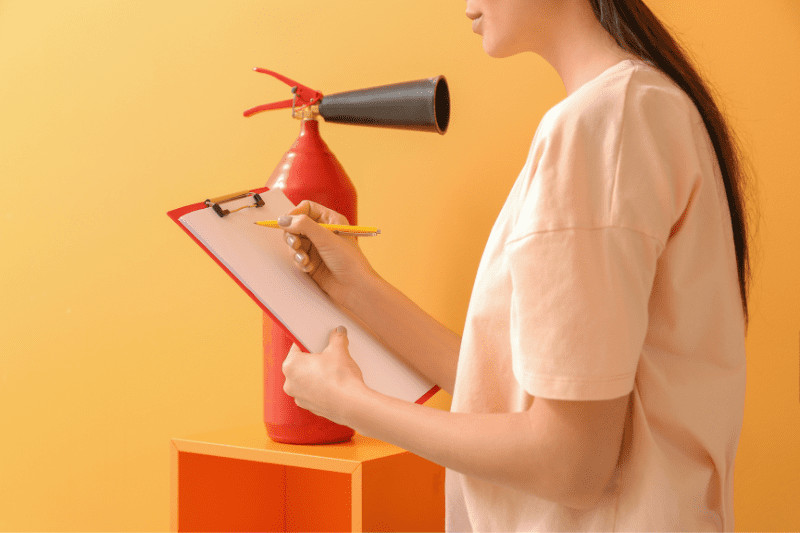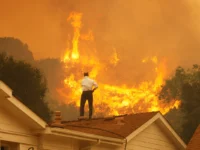Contents
- 1 The Importance of Fire Safety Equipment for Your Home
- 2 Fire Extinguishers: Your First Line of Defense
- 3 Smoke Alarms: Early Warning Systems
- 4 Fire Blankets: Effective Tools for Smothering Small Fires
- 5 Escape Ladders: Planning for Safe Evacuation
- 6 Fireproof Safes: Protecting Valuables and Important Documents
- 7 Carbon Monoxide Detectors: Detecting Silent and Deadly Threats
- 8 Sprinkler Systems: Automated Fire Suppression
- 9 Fire Escape Plans: Preparing for Emergency Situations
- 10 Training and Education: Equipping Yourself with Knowledge
Fire safety equipment for your home – We will explore the essential tools and devices that can help protect your household from the devastating effects of a fire. Whether you are a homeowner, a renter, or simply concerned about the safety of your loved ones, understanding the importance of having the right fire safety equipment is crucial. We will discuss the key items you should have in your home, their functions, and how they can significantly reduce the risks associated with fires. So, let’s dive in and equip ourselves with the knowledge to keep our homes safe.
The Importance of Fire Safety Equipment for Your Home
When it comes to the safety and well-being of your household, fire prevention should be a top priority. Fires can occur unexpectedly, causing extensive damage to property and posing significant risks to occupants. Having the right fire safety equipment in place can make all the difference in protecting your home and loved ones.
Preventing Loss and Damage: Fire safety equipment acts as a crucial line of defense against potential fires. By having the proper tools readily available, you can significantly reduce the risk of a small fire turning into a devastating disaster. Fire extinguishers, smoke alarms, and fire blankets are essential items that can help control and extinguish fires before they spread.
Early Detection: Smoke alarms are vital components of fire safety equipment as they provide early warning signs of a fire. These devices are designed to detect smoke particles in the air, triggering a loud alarm to alert occupants. Early detection allows for swift action, providing valuable time to evacuate and call emergency services.
Safe Evacuation: In the event of a fire, having an established escape plan is crucial. Fire escape ladders provide a safe means of evacuation from upper floors, ensuring everyone can quickly and safely exit the building. By including escape ladders as part of your fire safety equipment, you can confidently plan for a swift and secure evacuation.
Protecting Valuables: Fireproof safes are an essential addition to any home’s fire safety equipment. These safes are designed to withstand high temperatures and protect valuable items, important documents, and irreplaceable possessions. By storing these items in a fireproof safe, you can have peace of mind knowing they are protected in the event of a fire.
Investing in fire safety equipment is a proactive measure that every homeowner should take. By equipping your home with the necessary tools, you are not only safeguarding your property but also prioritizing the safety and well-being of your loved ones. In the following sections, we will delve deeper into each type of fire safety equipment, discussing their functions, installation, and maintenance, to help you make informed decisions for your home’s fire safety preparedness.
Fire Extinguishers: Your First Line of Defense
When it comes to combating fires, fire extinguishers are an essential tool that can make a significant difference in minimizing damage and ensuring the safety of occupants. Understanding the different types of fire extinguishers and their proper usage is crucial for effective fire prevention.
Types of Fire Extinguishers
1. Water Extinguishers: These extinguishers are suitable for fires involving combustible materials such as wood, paper, and fabric. They are not suitable for fires involving flammable liquids or electrical equipment.
2. Foam Extinguishers: Foam extinguishers are effective for fires caused by flammable liquids like petrol, oil, or paints. The foam creates a barrier, separating the fire from the oxygen supply and extinguishing it.
3. Carbon Dioxide (CO2) Extinguishers: CO2 extinguishers are designed for fires involving electrical equipment, such as computers, appliances, or electrical wiring. The CO2 gas displaces oxygen, suffocating the fire without leaving residue or causing damage to sensitive equipment.
4. Dry Powder Extinguishers: Dry powder extinguishers are versatile and can be used on various types of fires, including those involving flammable liquids, electrical equipment, and combustible solids. However, the residue left behind may require thorough cleaning after use.
5. Wet Chemical Extinguishers: Wet chemical extinguishers are specifically designed for fires involving cooking oils and fats, commonly found in kitchens. The extinguishing agent reacts with the hot oil, forming a soap-like solution that seals the surface and prevents re-ignition.
Proper Handling and Maintenance
Simply having a fire extinguisher is not enough; it is essential to understand how to use it correctly:
– Familiarize yourself with the PASS technique: Pull the pin, Aim at the base of the fire, Squeeze the handle, and Sweep the extinguisher from side to side.
– Regularly inspect your fire extinguisher to ensure it is not damaged or expired. Check the pressure gauge and ensure it is within the recommended range.
– Follow the manufacturer’s instructions for maintenance, which may include periodic servicing and recharging.
– Place fire extinguishers in easily accessible locations, ensuring they are not blocked by furniture or other objects.
Remember, fire extinguishers should only be used on small, contained fires. If the fire becomes uncontrollable, evacuate immediately and call emergency services. Your safety should always come first.
Smoke Alarms: Early Warning Systems
Smoke alarms are vital components of any home’s fire safety system. These devices play a critical role in detecting fires at their early stages, providing occupants with the necessary time to evacuate and seek help. Understanding the importance of smoke alarms and their proper installation and maintenance is key to ensuring the safety of your home and loved ones.
How Smoke Alarms Work
Smoke alarms operate on a simple yet effective principle. They consist of a sensor that detects smoke particles in the air, triggering an alarm to alert occupants of a potential fire. There are primarily two types of smoke alarms:
1. Ionization Smoke Alarms: These alarms use a small amount of radioactive material to ionize the air inside the alarm chamber. When smoke enters the chamber, it disrupts the ionization process, triggering the alarm.
2. Photoelectric Smoke Alarms: Photoelectric alarms work by using a light beam and a sensor. When smoke particles enter the chamber, they scatter the light, causing it to hit the sensor and trigger the alarm.
Installation and Maintenance
Proper installation and maintenance of smoke alarms are crucial for their effectiveness:
– Install smoke alarms on every level of your home, including inside and outside sleeping areas.
– Follow the manufacturer’s instructions for installation, ensuring they are securely mounted on the ceiling or high on the wall, away from corners and vents.
– Test your smoke alarms monthly by pressing the test button to ensure they are functioning correctly.
– Replace the batteries in battery-operated smoke alarms at least once a year, or when the low-battery warning chirps.
– Clean your smoke alarms regularly by gently vacuuming them to remove dust and debris that may affect their performance.
– Replace smoke alarms every ten years or as recommended by the manufacturer, as their effectiveness may decrease over time.
Remember, smoke alarms are life-saving devices that provide early warning in the event of a fire. Regularly maintaining and testing your smoke alarms can significantly increase your chances of a safe escape. It is also essential to educate all household members on the sound of the alarm and the necessary actions to take when it goes off.
Fire Blankets: Effective Tools for Smothering Small Fires
Fire blankets are valuable tools in fire safety, particularly for smothering small fires and preventing them from spreading. These blankets are made from fire-resistant materials and are designed to extinguish flames by cutting off the fire’s oxygen supply. Understanding the purpose and proper use of fire blankets can greatly enhance your ability to respond effectively to fire emergencies.
How Fire Blankets Work
Fire blankets work by smothering the flames, depriving them of oxygen and causing them to extinguish. They are typically made from non-flammable materials such as fiberglass, wool, or specially treated fabrics. When thrown or wrapped around a small fire, the blanket forms a barrier, preventing the flames from spreading and reducing the risk of injury or property damage.
Using a Fire Blanket
When using a fire blanket, it is important to follow these steps:
1. Assess the Situation: Evaluate the size and intensity of the fire. Fire blankets are most effective for small fires, such as those involving a small pan or clothing. If the fire is large or spreading rapidly, evacuate immediately and call emergency services.
2. Protect Yourself: Before approaching the fire, ensure you are wearing appropriate protective clothing, including heat-resistant gloves and non-flammable clothing.
3. Remove the Blanket: Remove the fire blanket from its storage container or pouch, making sure to hold it by the corners or designated handles to avoid getting burned.
4. Cover the Fire: Carefully place the blanket over the flames, ensuring it completely covers the burning area. Avoid getting too close to the fire to minimize the risk of burns.
5. Cut off the Oxygen: Once the fire is covered, use gentle pressure to press the blanket against the fire’s base and surrounding areas, effectively cutting off the oxygen supply.
6. Leave the Blanket in Place: After the flames have been extinguished, leave the blanket in place for at least 30 minutes to ensure the fire is completely out and to prevent reignition.
7. Seek Professional Assistance: Even if the fire appears to be fully extinguished, it is important to contact the fire department or a professional to inspect the area and ensure there are no hidden hot spots or potential hazards.
Fire blankets are effective tools for smothering small fires and should be readily accessible in areas prone to fire hazards, such as kitchens or workshops. Familiarize yourself with the location of fire blankets in your home and ensure that all household members know how to use them correctly in case of emergency.
Escape Ladders: Planning for Safe Evacuation
In multi-story homes or buildings, having a reliable escape plan is crucial for safe evacuation during a fire emergency. Escape ladders are essential tools that provide a secure means of exiting upper floors when traditional exits are inaccessible. Understanding the importance of escape ladders and how to select, install, and use them properly can greatly enhance your preparedness for fire emergencies.
Selecting the Right Escape Ladder
When choosing an escape ladder, consider the following factors:
1. Length: Measure the distance from the highest window to the ground to ensure the ladder is long enough to reach. It’s recommended to choose a ladder that extends a few feet beyond the window sill for added safety.
2. Weight Capacity: Check the weight capacity of the ladder to ensure it can support the combined weight of individuals who may need to use it during an emergency.
3. Durability and Construction: Look for escape ladders made from sturdy materials such as steel or aluminum. Ensure that the ladder is designed with anti-slip rungs or steps to provide secure footing during descent.
4. Ease of Use: Consider the ladder’s deployment and storage mechanisms. Choose a ladder that is easy to set up quickly and can be easily stored in a convenient location near the designated escape window.
Installing and Using an Escape Ladder
Follow these steps for proper installation and use of an escape ladder:
1. Familiarize Yourself: Read the manufacturer’s instructions thoroughly and become familiar with the ladder’s components, mechanisms, and usage instructions.
2. Install Securely: Install the ladder near a window designated as an emergency escape route. Ensure it is securely mounted and easily accessible. Regularly check the ladder’s mounting brackets or hooks to ensure they are in good condition.
3. Practice: Conduct regular drills with all household members to ensure everyone knows how to use the escape ladder quickly and safely. Familiarize yourself with the ladder’s deployment process and practice descending from the window to the ground.
4. Keep the Exit Clear: Ensure the area around the designated window and ladder exit remains clear of obstacles or debris that may impede a quick and safe evacuation.
5. Evacuate Safely: In a fire emergency, follow your predetermined escape plan. Escape through the designated window, attach the ladder securely to the window sill or escape point, and descend carefully, one person at a time.
Remember, escape ladders are designed for one-time use during emergencies. After use, it is essential to replace the ladder with a new one to ensure its reliability for future emergencies. By incorporating escape ladders into your fire safety plan, you can enhance your ability to evacuate safely and effectively from upper floors in the event of a fire.
Fireproof Safes: Protecting Valuables and Important Documents
Fireproof safes are essential additions to any home’s fire safety equipment. These safes are specially designed to withstand high temperatures and protect valuable items, important documents, and irreplaceable possessions from fire damage. Understanding the benefits of fireproof safes, how to choose the right safe, and what items to store in them can give you peace of mind knowing your most valuable belongings are safeguarded in the event of a fire.
The Benefits of Fireproof Safes
Fireproof safes offer several advantages when it comes to protecting your valuables:
1. Fire Resistance: Fireproof safes are constructed with materials that can withstand high temperatures, typically ranging from 1200°F to 1700°F (649°C to 927°C), for a specified period, such as 30 minutes to 2 hours. This allows your belongings to remain protected even in the event of a fire.
2. Protection from Smoke and Water: In addition to withstanding high temperatures, fireproof safes are often designed to provide protection against smoke and water damage. The sealed construction helps keep out smoke and chemicals, while the safe’s waterproof feature prevents water from seeping in during fire suppression efforts.
3. Theft Deterrence: Fireproof safes are typically heavy and securely built, making them more resistant to theft attempts. They can serve as an additional layer of protection for your valuable items, deterring potential burglars.
Choosing the Right Fireproof Safe
Consider the following factors when selecting a fireproof safe:
1. Fire Rating: Look for safes with a fire rating that matches your desired level of protection. Consider the type of items you plan to store and the duration of protection you require.
2. Size and Capacity: Determine the size and capacity of the safe based on the items you intend to store. Ensure it is large enough to accommodate your belongings without overcrowding them.
3. Locking Mechanism: Consider the type of locking mechanism that suits your needs, whether it’s a traditional key lock, combination lock, or electronic keypad lock.
4. Durability and Construction: Opt for safes made from high-quality, fire-resistant materials such as steel. Look for safes with solid construction and robust hinges to withstand the impact of a fire or attempted break-ins.
Items to Store in a Fireproof Safe
Fireproof safes are ideal for storing various valuable items and documents, including:
– Important legal documents (e.g., passports, birth certificates, wills, property deeds)
– Insurance policies and medical records
– Backup hard drives or digital storage devices
– Jewelry, cash, and valuable collectibles
– Family heirlooms and sentimental items
Remember to periodically review the contents of your fireproof safe and update it as necessary, removing any outdated or unnecessary items.
Investing in a fireproof safe is a proactive step towards protecting your most valued possessions. By keeping your important documents and valuable items secure within a fireproof safe, you can have peace of mind knowing they are safeguarded, even in the face of a fire emergency.
Carbon Monoxide Detectors: Detecting Silent and Deadly Threats
Carbon monoxide (CO) detectors are essential devices for every home, as they help detect the presence of this odorless, colorless, and highly toxic gas. Carbon monoxide is produced by the incomplete combustion of fuels such as gas, oil, coal, and wood, and can pose a serious threat to human health. Understanding the dangers of carbon monoxide poisoning, the importance of carbon monoxide detectors, and how to properly install and maintain them can help keep your household safe from this silent killer.
The Dangers of Carbon Monoxide Poisoning
Carbon monoxide is often referred to as the “silent killer” because it is virtually impossible to detect without the aid of a carbon monoxide detector. When inhaled, carbon monoxide displaces oxygen in the bloodstream, leading to severe health issues or even death. Common sources of carbon monoxide include malfunctioning fuel-burning appliances, vehicle exhaust fumes, and blocked chimneys.
The Role of Carbon Monoxide Detectors
Carbon monoxide detectors play a vital role in detecting the presence of carbon monoxide gas in your home. They are designed to sound an alarm when carbon monoxide levels reach dangerous concentrations, giving occupants an early warning sign to evacuate and seek fresh air. Carbon monoxide detectors are particularly crucial in homes with fuel-burning appliances, attached garages, or fireplaces.
Installation and Maintenance
Proper installation and maintenance of carbon monoxide detectors are crucial for their effectiveness:
1. Placement: Install carbon monoxide detectors on every level of your home, including outside sleeping areas. Place them on walls, at least 5 feet above the ground, or on the ceiling for optimal coverage.
2. Follow Manufacturer’s Instructions: Read and follow the manufacturer’s instructions for installation, positioning, and testing of your specific carbon monoxide detector model.
3. Regular Testing: Test your carbon monoxide detectors monthly by pressing the test button to ensure they are functioning correctly and sounding the alarm as intended.
4. Battery Replacement: Replace the batteries in your carbon monoxide detectors at least once a year, or as recommended by the manufacturer. Some models have sealed, non-replaceable batteries that last for the entire lifespan of the detector.
5. Detector Lifespan: Carbon monoxide detectors typically have a lifespan of 5 to 7 years. After this period, replace them with new units to ensure their continued effectiveness.
6. Pay Attention to Warning Signals: If your carbon monoxide detector sounds an alarm or emits a warning signal, immediately evacuate the premises and seek fresh air. Call emergency services to investigate the source of carbon monoxide and ensure your safety.
Carbon monoxide detectors are essential devices for protecting your household from the dangers of carbon monoxide poisoning. By installing and maintaining these detectors in your home, you can have peace of mind knowing that you have an early warning system in place to detect this silent and deadly threat.
Sprinkler Systems: Automated Fire Suppression
Sprinkler systems are highly effective tools for fire suppression, offering automated protection that can rapidly control and extinguish fires in homes. These systems are designed to detect and respond to fires early, minimizing damage, and providing valuable time for occupants to evacuate safely. Understanding the benefits of sprinkler systems, their installation process, and the importance of regular maintenance can significantly enhance your home’s fire safety measures.
The Effectiveness of Sprinkler Systems
Sprinkler systems are proven to be highly effective in fire suppression:
1. Rapid Response: Sprinkler systems are designed to detect fires in their early stages. Once a fire is detected, the sprinklers closest to the source activate, releasing water directly onto the flames, helping to control and extinguish the fire before it can spread further.
2. Quick Heat Dissipation: The water released by sprinklers helps reduce the temperature in the area, limiting the fire’s ability to grow and preventing it from spreading to adjacent rooms or areas.
3. Simultaneous Activation: Each sprinkler head operates independently, meaning only the sprinklers directly affected by the fire will activate. This helps minimize water damage to unaffected areas of the home.
4. Life-Saving Potential: Sprinkler systems can provide valuable time for occupants to evacuate the premises safely. When combined with smoke alarms, the early detection and rapid response of sprinklers can significantly increase the chances of survival during a fire emergency.
Installation and Maintenance
Proper installation and maintenance are essential for the effectiveness of sprinkler systems:
1. Professional Installation: Sprinkler systems should be installed by qualified professionals who have expertise in designing and implementing these systems. They will ensure the system is tailored to the specific needs of your home and complies with local building codes and regulations.
2. Regular Inspections: Schedule regular inspections by professionals to check the condition of your sprinkler system. This includes examining the sprinkler heads, pipes, valves, and control panel to ensure they are in good working order.
3. Testing and Maintenance: Test your sprinkler system regularly to ensure it is functioning correctly. This includes checking the water pressure, inspecting the control valves, and conducting flow tests to ensure the water distribution is adequate.
4. Clear Obstructions: Ensure that sprinkler heads and the area around them are not obstructed by furniture, decorations, or other objects. This allows the sprinklers to operate effectively and provides unobstructed water distribution.
5. Education and Awareness: Educate household members about the purpose and operation of the sprinkler system. Ensure they understand the importance of not tampering with or obstructing the sprinklers.
Installing a sprinkler system in your home is a proactive step towards enhancing your fire safety. By providing rapid response and effective fire suppression, sprinkler systems can significantly reduce the risk of extensive damage and potential loss of life during a fire emergency.
Fire Escape Plans: Preparing for Emergency Situations
Creating a fire escape plan is an essential aspect of fire safety preparedness for every household. Fire escape plans outline the necessary steps to take in the event of a fire, ensuring a swift and organized evacuation. By developing and practicing a well-designed fire escape plan, you can significantly increase your chances of a safe evacuation and minimize the risks associated with fire emergencies.
The Importance of Fire Escape Plans
Fire escape plans provide several key benefits:
1. Clear Guidance: A fire escape plan provides clear instructions and designated escape routes for all household members. It ensures that everyone knows the quickest and safest way to exit the building in case of a fire.
2. Efficient Evacuation: By having a predetermined escape plan, you can minimize confusion and panic during an emergency. This allows for a more efficient and organized evacuation, especially in high-stress situations.
3. Consideration of Individual Needs: Fire escape plans take into account the specific needs of every household member, including children, elderly individuals, or individuals with disabilities. It ensures that everyone’s unique requirements are considered when creating evacuation strategies.
4. Preparedness and Confidence: Practicing fire escape drills regularly instills confidence and preparedness in household members. It familiarizes them with the escape routes and procedures, making them more likely to respond quickly and calmly during an actual emergency.
Developing a Fire Escape Plan
When developing a fire escape plan, consider the following guidelines:
1. Identify Escape Routes: Identify at least two escape routes from every room in your home. This includes primary routes, such as doors, and secondary routes, such as windows.
2. Designate a Meeting Point: Choose a designated meeting point outside the home where all household members should gather after evacuating. This ensures that everyone can be accounted for and prevents unnecessary re-entry into the building.
3. Practice Regularly: Conduct fire drills at least twice a year, practicing the evacuation routes and meeting at the designated meeting point. Ensure that household members know how to react in different scenarios, including escaping from different rooms or during nighttime hours.
4. Communicate and Educate: Share the fire escape plan with all household members, ensuring everyone understands their roles and responsibilities. Educate children on the importance of fire safety and teach them how to respond during an emergency.
5. Review and Update: Regularly review and update your fire escape plan as needed. This includes making modifications for changes in the layout of your home or adjustments based on the ages and abilities of household members.
Remember, a fire escape plan is a vital part of your overall fire safety preparedness. Regularly practicing and reviewing the plan with all household members can greatly enhance your ability to respond effectively in the event of a fire emergency.
Training and Education: Equipping Yourself with Knowledge
When it comes to fire safety, knowledge is power. By investing in proper training and education, you can equip yourself with the necessary skills and understanding to prevent fires, respond effectively in emergency situations, and protect your household. Understanding the importance of fire safety training and education, as well as the available resources for improving fire safety awareness, can make a significant difference in your preparedness and overall safety.
The Significance of Fire Safety Training
Fire safety training offers numerous benefits:
1. Prevention: Fire safety training helps you identify potential fire hazards in your home and take proactive measures to prevent fires from occurring. It teaches you about safe practices, such as proper use and storage of flammable materials, electrical safety, and safe cooking practices.
2. Emergency Response: Training equips you with the knowledge and skills to respond effectively during a fire emergency. This includes knowing how to safely evacuate, use fire extinguishers, and implement your fire escape plan.
3. Increased Awareness: Fire safety training raises awareness about the dangers of fires and the importance of fire prevention measures. It helps you understand the risks associated with specific activities and behaviors, enabling you to make informed decisions to minimize those risks.
Available Resources for Fire Safety Education
There are various resources available to enhance your fire safety knowledge:
1. Local Fire Departments: Many local fire departments offer fire safety training programs and materials. They may provide educational materials, conduct community workshops, or offer hands-on training sessions.
2. Online Courses and Webinars: Numerous online platforms offer fire safety courses and webinars that cover a wide range of topics, from basic fire prevention to advanced emergency response techniques. These courses can be completed at your own pace and convenience.
3. Fire Safety Websites and Blogs: Fire safety websites and blogs provide valuable information on fire prevention, safety tips, and emergency preparedness. They often publish articles, infographics, and videos to educate readers on various fire safety topics.
4. Fire Safety Literature: Books, manuals, and pamphlets on fire safety provide in-depth knowledge on the subject. They cover a range of topics, including fire prevention, emergency response, and building codes and regulations.
5. Fire Safety Apps: There are mobile applications available that offer fire safety tips, emergency preparedness checklists, and even virtual simulations for practicing fire escape plans. These apps can be a convenient and interactive way to enhance your fire safety knowledge.
By taking advantage of these resources and actively seeking out fire safety training and education, you can enhance your understanding of fire prevention and response. This knowledge empowers you to take the necessary steps to protect your home, loved ones, and yourself from the devastating effects of fires.
In conclusion, fire safety equipment plays a vital role in protecting your home and loved ones from the devastating effects of fires. By understanding the importance of having the right tools and devices, such as fire extinguishers, smoke alarms, fire blankets, escape ladders, fireproof safes, carbon monoxide detectors, sprinkler systems, and having a well-designed fire escape plan, you can significantly enhance your preparedness and increase your chances of a safe evacuation in case of a fire emergency.
Proper installation, maintenance, and regular testing of fire safety equipment are crucial for their effectiveness. It is also essential to stay updated with the latest fire safety knowledge through training, education, and utilizing available resources. By equipping yourself with the necessary knowledge and skills, you can prevent fires, respond effectively during emergencies, and minimize the risks associated with fire incidents.
Remember, fire safety is a collective effort that requires the participation and cooperation of every household member. Regularly practice fire drills, communicate your fire escape plan, and educate everyone on the importance of fire prevention and safety measures. By prioritizing fire safety in your home, you can create a safer environment for yourself, your loved ones, and your belongings.
Investing in fire safety equipment and staying informed about fire prevention measures are proactive steps towards safeguarding your home. By implementing these measures and continuously prioritizing fire safety, you can enjoy peace of mind knowing that you have taken the necessary precautions to protect what matters most.

Passionate about preserving lives and protecting properties, John Sarver is a dedicated advocate for fire safety. With an unwavering commitment to educating and empowering communities, he has become a prominent voice in the field. As the founder and author of the influential blog “SarverFire,” John’s mission is to share invaluable insights, tips, and resources to enhance fire safety awareness and preparedness.





